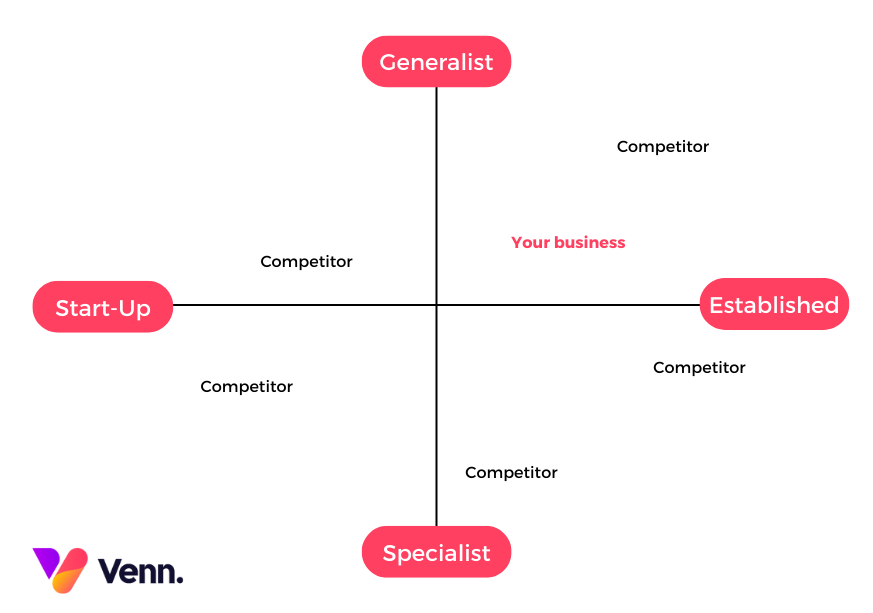Explore our NEW Knowledge Base and Help Desk to find everything you need to attract, engage and convert talent with your Vennture website.
Discover More5 Simple Steps for Market Mapping in Recruitment
23 Jan, 20233 minutes
Whether your business has been in operation for over 20 years or if you’re just starting out, market mapping is vital in understanding your USPs, identifying gaps in the market and creating effective recruitment marketing strategies.
Perhaps you’re getting to grips with the business goals for 2023, or maybe you’ve recently taken on a new website build, in which case now may just be the perfect time to review your market map or start fresh to determine who your competitors are and where you sit in the recruitment agency market.
What is marketing mapping in recruitment?
Market mapping uses competitive analysis and data-driven research to plot out a business’s competitors on a graph determined by two sets of variables. These variables will help you identify and segment the market seeing where supply, demand, saturation and opportunities occur. If done correctly, market mapping can become a core aspect of any recruitment marketing strategy. Once plotted, these maps can help businesses:
- Improve their product or service offering
- Spot gaps in the market and discover new growth opportunities
- Identify their closest competitors to carry out further analysis
How does market mapping help a business?
Competitive analysis can help you uncover a wealth of information about your business and position in the market. It can also provide insight into your competitors, including who they are, their strengths and weaknesses, the effectiveness of their marketing strategies, and how they target audiences.
Once plotted, these maps also benefit businesses in identifying market trends and creating long-term recruitment marketing strategies, capitalising on unexplored opportunities and developing their own products or services.
Types of market mapping in recruitment?
There are typically two market mapping approaches available to recruitment marketers looking to gain more insights into their competitors and target audience. These approaches are called Perceptual Mapping and Position Mapping. Whilst both methods will require similar research and can sometimes be used interchangeably, there are key differences between the two that should be considered before you begin.
Perceptual market mapping
Perceptual market mapping involves taking the perceived position of competitor brands, usually identified through market research. As the word ‘perceptual’ implies, this method is not based on data. Instead, it’s usually formed from customer surveys to provide their perception of your brand's position in the recruitment market compared to competitors.
Perceptual mapping does have a place within position mapping, but on its own doesn’t show the reality of the market or where they want to be; instead, it shows how consumers view your brand. This method is based on quantitative data. It can help recruitment agencies create a quick visual representation of the market and understand market segments, informing their future market and service developments.
Position market mapping
On the other hand, position market mapping allows you to map out where your brand currently stands in the market based on facts or where you would like to be, using key differentiators. Usually presented in the same way, both approaches use scatter charts to show their market location compared to competitor brands.
Using two dimensions, such as specialist > generalist and start-up > established (as shown below), agencies can develop physical maps to spot gaps in the market, close competition and where you would ideally like to be. Using a position map, you can analyse how competitors differentiate themselves, helping you create an effective recruitment marketing strategy.
How to do market mapping in recruitment
High-performing recruitment marketing strategies start with effective planning. Getting started with position market mapping involves proactive market research, helping you understand your competitor's business proposition. Whether you’re reviewing your last market map or tackling one for the first time, we’ve broken down our 5 step approach to help you out.
1. Define your objective
Before you begin your analysis, it is essential to establish your objectives and goals to help you understand what variables you are measuring yourself against. Looking at the wider context of marketing mapping, recruitment agencies may plot themselves on a variety of factors depending on their product or service. We’ve included some example variables you could measure when plotting a market map in recruitment:
- Established vs Start-Up
- 360 vs 180
- Generalist vs Specialist
- Conversion rate vs Traffic rate
- Keyword volume vs Search engine position
2. Research and identify your competitors and target audiences
To ensure you’re creating an accurate analysis, you should start by researching who your competitors are. Most businesses will already have a general idea of who their competitors are, including those they aspire to be like, but through some research, you may uncover new competitors to the market or ones to keep an eye on.
Your competitors should consist of companies that provide a solution to the same issue as your service or address similar customer needs. This is also a great time to map out your audience/customer personas that you want to target to identify their pain points, drivers and unique characteristics.
You can learn more about our audience personas guides here and use our recruitment marketing templates to get started.
Start with a simple google search. Search for generic keywords relating to services, industries or specialisms similar to your business. It’s also important to note which companies are occupying the top search positions on page one, which may provide insight when it comes to creating content strategies and optimising your website for search.
Finally, make a note of around 10-15 competitors that you feel are a close comparison for the service you provide or the industry you work in. Once you’ve got your list, you’re ready to start plotting!
3. Plot your chosen competitors
Begin to plot your competitors on your map depending on the variables you’re measuring. Take a look at the example below; we’ve chosen to look at established vs start-up recruitment companies and plot them against those that are generalists or specialists in their fields. Depending on what you’re measuring, plot your chosen competitors against each of the variables, placing them in an estimated location of where you’d expect them to sit.
Top Tip: Stay objective when plotting yourself against your competitors to get an accurate overview of the market!
Example
1: Competitor Positioning Map created by Venn Digital

4. Analyse the results
Now you’ve got your plotted map, and you can start to see where you’ve placed yourself against the competition. Here are some questions to ask yourself to help you analyse your map:
- Is the position I’ve placed myself within in the market too saturated?
- Where are the gaps in the market that I can capitalise on?
- What’s our USP against some of our closest competitors?
As you start to see the market in full view, you can identify opportunities that your competitors may not have thought about. Competitor analysis is extremely beneficial for recruitment marketers when creating content plans and strategies. You first need to understand what competitors are doing well to stand out in your market. This will help you design impactful content for your audience.
5. Reflect and review
Now you’ve completed your market map and competitor analysis, it's time to take a step back and analyse the businesses operating within your industry/sector. Before you relax, the work is far from over.
The thing to keep in mind about market mapping, particularly within recruitment, is that things change quickly. This map may be accurate now, but with the number of UK recruitment agencies increasing by 3% between 2020 and 2021, the market can quickly look very different. So it’s important to create market maps regularly to track the data and visualise any market shifts or emerging trends.
It’s also worth noting that not every gap has potential and that you may have to experiment with different variables or competitors to find some actionable data. Repeating this task regularly will help you understand your market and create your own analysis to take forwards into future campaigns, plans or strategies.
Why is market mapping important?
Market mapping provides an effective framework for recruitment marketing and business development. Conducting research and creating a positioning map helps agencies to unite their understanding of where they stand in the market, identifying gaps, opportunities and threats.
If you’re looking for recruitment marketing support to optimise your strategy for 2023, speak to one of our experts today. Venn is home to a team of recruitment marketing specialists and digital gurus who are ready to help. Explore our approach to recruitment marketing for more information on our services.



